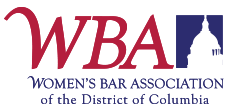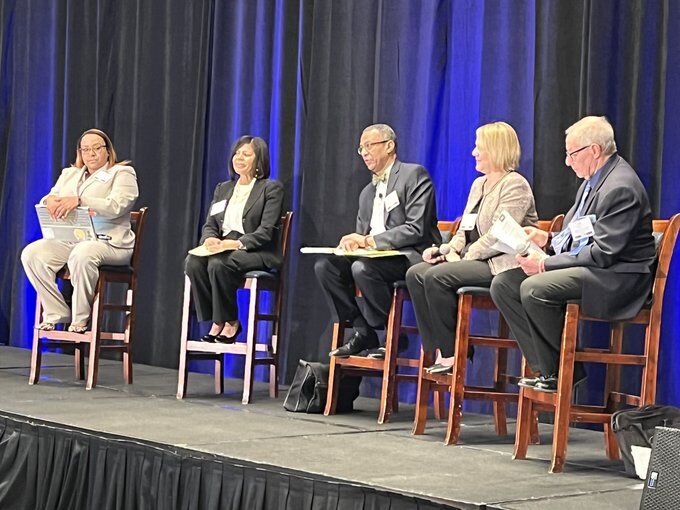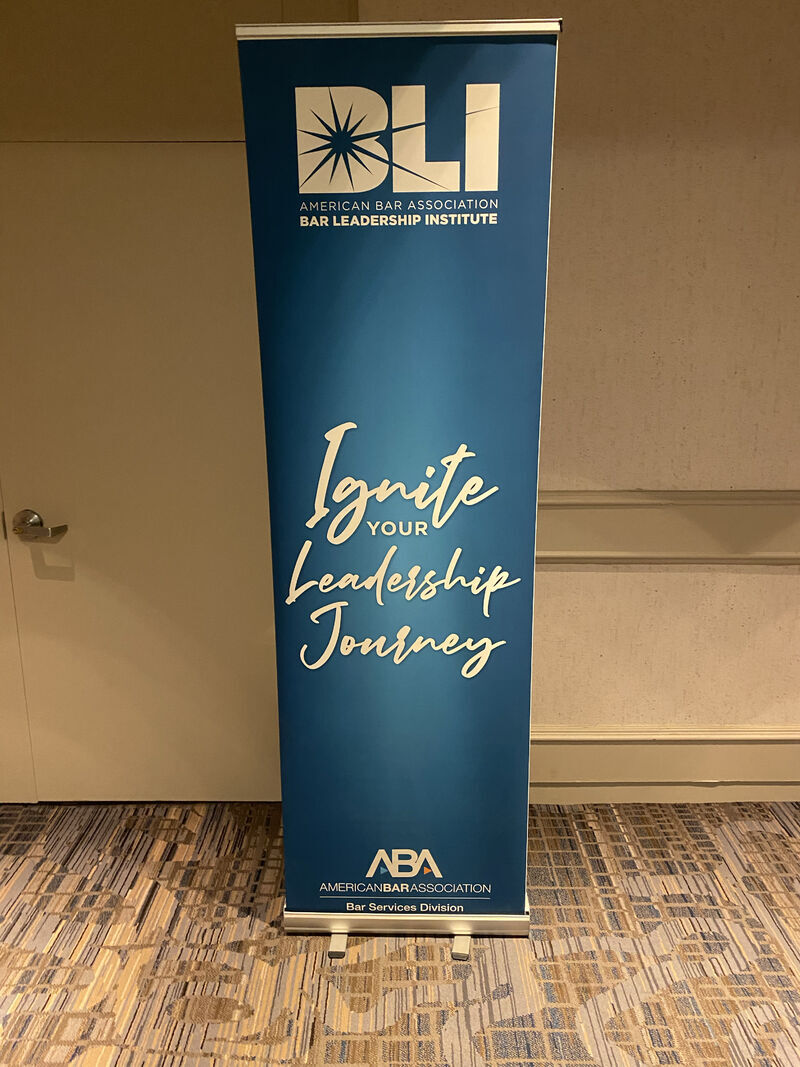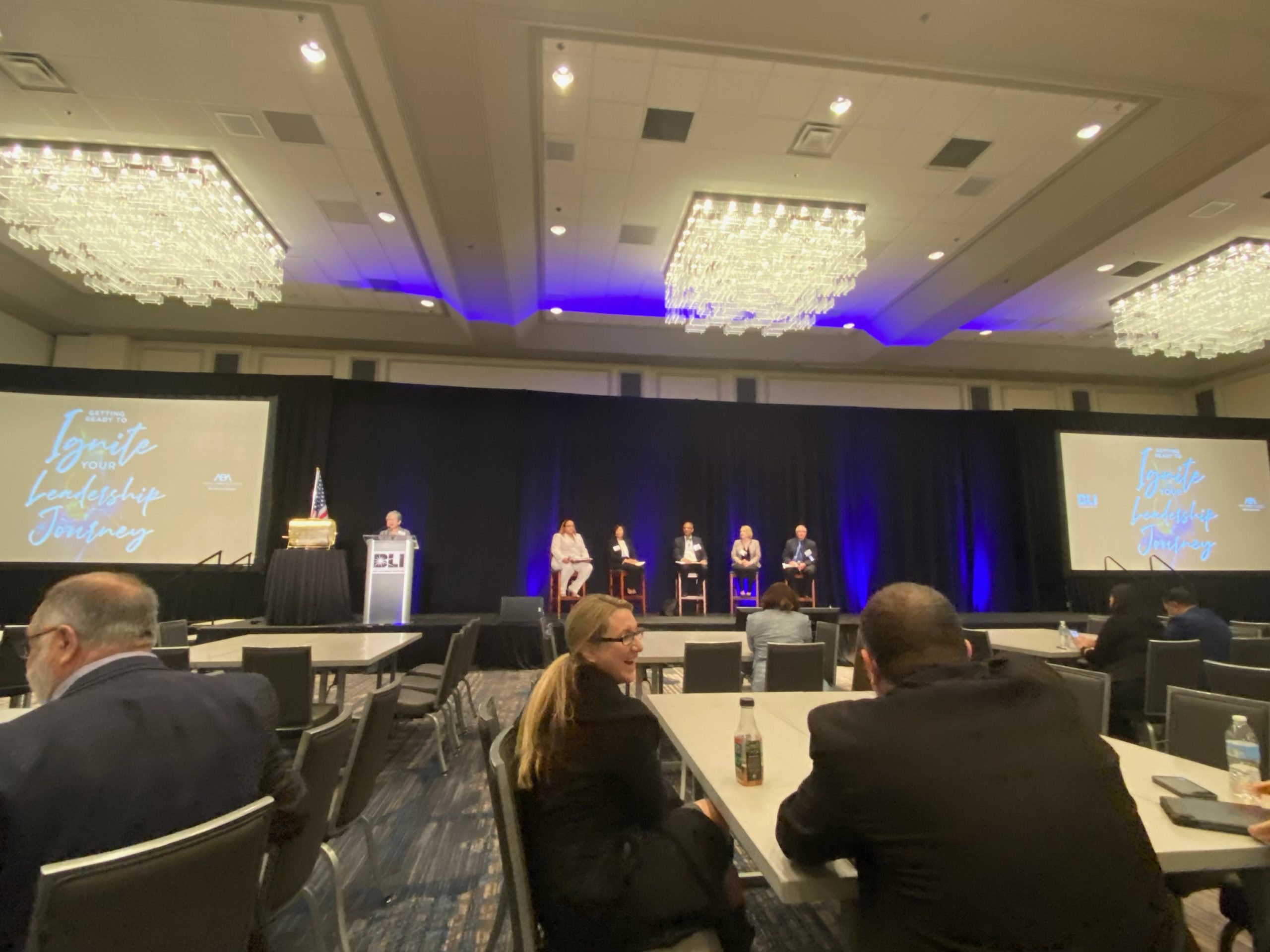By Bridget Bailey Lipscomb, WBA President, 2021-2022
One of the many perks of serving as President of the Women’s Bar Association of the District of Columbia (WBA) is having the opportunity to speak about WBA’s prolific programs. Accordingly, I had the honor of representing the WBA at the ABA 2022 Bar Leadership Institute (BLI) during a session entitled, “Courageous Leadership: Get Out of Your Comfort Zone.” The session was designed to provide attendees with tips on how to lead their organizations through complex and difficult issues that may arise during their bar year. Carl Smallwood from Ohio State University Moritz College of Law moderated the session. The other panelists were Shawntal Mallory (spoke on Nebraska’s legal diversity efforts), Judge Brian Furuya (spoke on the State Bar of Arizona’s member outreach on a regulatory change to increase access to legal services), Fred Ury (spoke on regulatory reform and access to legal services more broadly in the United States), and Alicia Hernandez (spoke on the Dallas Bar’s decision to rename its building).
I proudly discussed the process the WBA undertook before deciding to serve as co-lead on the Dobbs v. Jackson Women’s Health Organization (the case on the Mississippi law banning abortion after 15 weeks of gestational age) amicus brief. I explained that considering the mission of the WBA when we learned about the Dobbs case and pending litigation in other states that threatened women’s right to make health decisions, the WBA Officers thought that it was critical for the WBA to be a leading voice on the issue. Coincidentally and fortunately, shortly thereafter, we were informed that based on the WBA’s 104-year history and continued pursuit to protect the interests of women, our organization was an attractive lead for the Dobbs amicus brief. After a few meetings with WBA Leadership and a WBA Board vote, we quickly accepted the invitation and started working on the brief.
The Challenge
This decision was a push even for the WBA because the WBA consists of a diverse group of members, some of whom do not believe that Roe v. Wade[1] and Planned Parenthood of Se. Pa. v. Casey[2] were correctly decided. We have members that believe that there should be restrictions on women’s reproductive health decisions.
A few years ago, after analyzing studies showing the increase in the number of women lawyers after Roe and how women continued to succeed in the profession, the WBA wanted to remove the stigma surrounding having an abortion. So, under the #OurBodiesOurVoices campaign, women lawyers who have had abortions were invited to give video interviews about their decision-making process and the impact of those decisions. That program generated some complaints and objections from some in the membership.
Thus, with the recent anti-stigma backdrop, we knew that serving as co-lead on an amicus brief that advocated for women’s constitutional right to end a pregnancy had a strong potential to be controversial. We knew that it might even cause us to lose members. But the benefit of speaking out outweighed the risk. As one of the oldest women’s bar associations in the country, the WBA needed to carry the burden and the mantle to protect these rights.
For almost 50 years, women have relied on this constitutional right. Even though women have not yet attained parity in the legal profession, the improvements that have been made in the lives and careers of women lawyers after Roe compelled us to take a lead role on this issue. The right to decide to end a pregnancy has been pivotal to gender equality and women’s health. In fact, the WBA’s position is best stated by Justice Blackmun’s concurrence to the Casey decision — “[b]ecause motherhood has a dramatic impact on women’s educational prospects, employment opportunities and self-determination, restrictive abortion laws deprive her of basic control over her life.”[3] Thus, the WBA could not stand idly by as our progress had the potential to regress.
The Process
Working from the backdrop of the strides since Roe and that fact we are still working for women to achieve parity in the legal profession even after Roe, the WBA was deliberate in its steps. We considered women’s accomplishments since Roe, the work in progress since Roe, and the consequences of Roe being overturned.
Accomplishments
The percentage of women lawyers was less than 4% in 1960, and increased to 38% in 2016.[4] The number of women attorneys between the ages of 25 to 34 is now on par with men.[5] The American Psychological Association has recognized a woman’s right to end a pregnancy a “civil right” because it so integral to women’s autonomy and well-being.[6]
Work in Progress
Women are still working towards equality in the legal profession. Women lawyers will not achieve gender parity until 2181.[7] Women make up about 40% of associates in law firms, but less than 24% of equity partners.[8] Women occupy, on average, about one-third of state and federal benches.[9] In 2019, women received only one out of every five Fortune 500 General Counsel positions.[10] Women law firm partners earn less than their male counterparts, regardless of how much they originate for the firm.[11] Male General Counsel are paid, on average, 39% more than their women counterparts.[12]
Consequences
Women who are denied the right to an abortion are more likely to stay with an abusive partner, experience poor physical health years after the pregnancy, and are less likely to fulfill aspirational life plans.[13] This is antithetical to everything the WBA stands for.
Realizing the risks associated with losing an almost 50-year constitutional right, WBA Officers discussed the invitation to draft the amicus brief. We considered our history, our mission, and how our founders were vocal on then-controversial issues, like the right to vote in 1917. We also discussed the pushback we received from the anti-stigma program. And, we recognized that taking the lead on this issue could alienate potential new members. However, after weighing the pros and cons, a decision was made to present the information to the Board of Directors. Our Board carefully analyzed all of the information presented, and after thorough deliberation, voted to serve as co-lead on the amicus brief. Since that time, we joined a rally at the Supreme Court when Dobbs was argued and we have had a robust three-part series on Reproductive Rights.
Feedback from Members
The WBA had previously received favorable feedback from the membership on its new advocacy initiatives. After George Floyd’s murder, our Board became very vocal in our stance against racism. This position seemed to increase our membership and engage our members like we had not seen in a while. We also, however, received limited criticism from some members that the WBA shouldn’t be a social justice organization. We explained our process for acting on social justice issues, and after the membership was informed through the website, written communications, and informal meetings that we only engage on issues that are tied to our mission and our strategic plan, the complaints were substantially diminished.
We subsequently had a town hall meeting to give our members and opportunity to weigh-in on the direction of WBA, and followed that up with a Member Survey. Based on these tools, we learned that the vast majority of our members were supportive of our advocacy.
Even though the decision to serve as co-lead on the Dobbs amicus brief had the potential to be catastrophic, it was in line with WBA’s mission, in line with the strategic plan, and it was the right thing to do to further gender parity in the legal field. We are hopeful that the Supreme Court of the United States considers our brief and protects women’s constitutional right to make decisions on their own health.
[1] 410 U.S. 113 (1973).
[2] 505 U.S. 833, 856 (1992).
[3] 505 U.S. 833, 928.
[4] Jennifer Cheeseman Day, More Than 1 in 3 Lawyers Are Women, U.S. CENSUS BUREAU (May 8, 2018), https://www.census.gov/library/stories/2018/05/women-lawyers.html.
[5] Id.
[6] See Resolution on Abortion (1969), AM. PSYCH. ASS’N (2009),
https://www.apa.org/about/policy/abortion; Alyson Zureick, (En)gendering Suffering: Denial of Abortion as a Form of Cruel, Inhuman, or Degrading
Treatment, 38 FORDHAM INTERNATIONAL LAW JOURNAL, 199 (2015).
[7] American Bar Association, In Their Own Words
(2021) at 3.
[8] Law360, These Firms Have the Most Women In Equity Partnerships (Sept. 14, 2021).
[9] See Democracy and Government Reform Team, Examining the
Demographic Compositions of U.S. Circuit and District Courts, CTR. FOR AM. PROGRESS at 4 (2020); 2019 Representation of United States State Court
Women Judges, NATIONAL ASSOCIATION OF WOMEN JUDGES (NAWJ) (2019), https://www.nawj.org/statistics/2019-us-state-courtwomen-judges.
[10] Ass’n of Corporate Counsel, The General Counsel Landscape at 18 (2019).
[11] Joan C. Williams et al., You Can’t Change What You Can’t See at 25 (2018).
[12] The 2019 General Counsel Landscape at 16 (2019).
[13] The Turnaway Study; Marianne Bitler & Madeline Zavodny, Child Abuse and Abortion Availability, 92 AM. ECON. REV. 363, 363-67 (2002).



